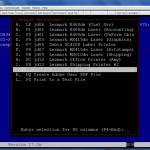There is a Linux command lpstat -t that will list all of the system print devices. If there are too many lines to completely display all devices on your screen, use the command lpstat -t |more.
Each print device has a device name and an individual IP address for each one. Each device will show it is accepting requests and whether or not the device is idle , enabled or currently executing a print job.
 The Total Order Plus printer menu will have the print device name before the description of each printer so you can cross reference the two print device names.
The Total Order Plus printer menu will have the print device name before the description of each printer so you can cross reference the two print device names.
Login as root and enter the system password.
# lpstat -t |more
If a print device shows disabled, you will be able to see the device name i.e. ps01 disabled. If there are numerous print jobs listed for the disabled print device, you will need to cancel all of them prior to executing the enable command.
# cancel -a ps01
# cupsenable ps01
Notes:
There are reasons why a print device might be disabled. If a user takes a printer offline during a print job, if a printer is turned off to try and cancel a print job or CUPS (Common UNIX (Linux) Printing System) will disable a printer if it doesn’t respond after a certain amount of time.
If you want to cancel an individual print job, enter this command:
# cancel ps01-1234 (1234 being the number of the print job)
If you see Network host ‘192.168.1.101’ is busy, it usually means the device is not connected to the network. You can execute the following command to test the connection:
# ping 192.168.1.101
If the device is connected, you will see the data packets that are transmitted and received.
PING 192.168.1.101: 56 data bytes
64 bytes from 192.168.1.101 (192.168.1.101): icmp_seq=0 ttl=60 time=150 ms
64 bytes from 192.168.1.101 (192.168.1.101): icmp_seq=1 ttl=60 time=101 ms
— 192.168.1.101 ping statistics —
2 packets transmitted, 2 packets received, 0% packet loss
round-trip min/avg/max = 101/125/150 ms

